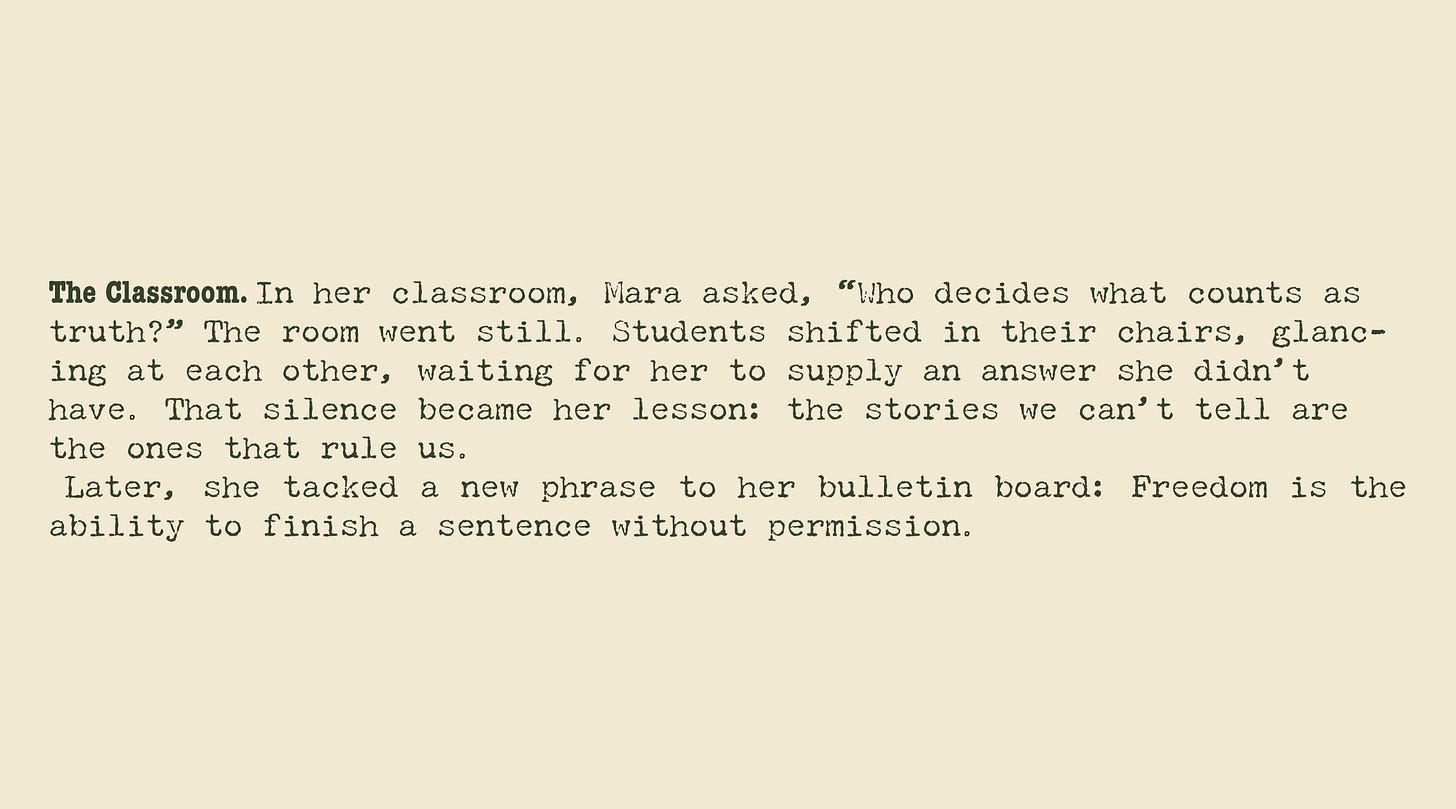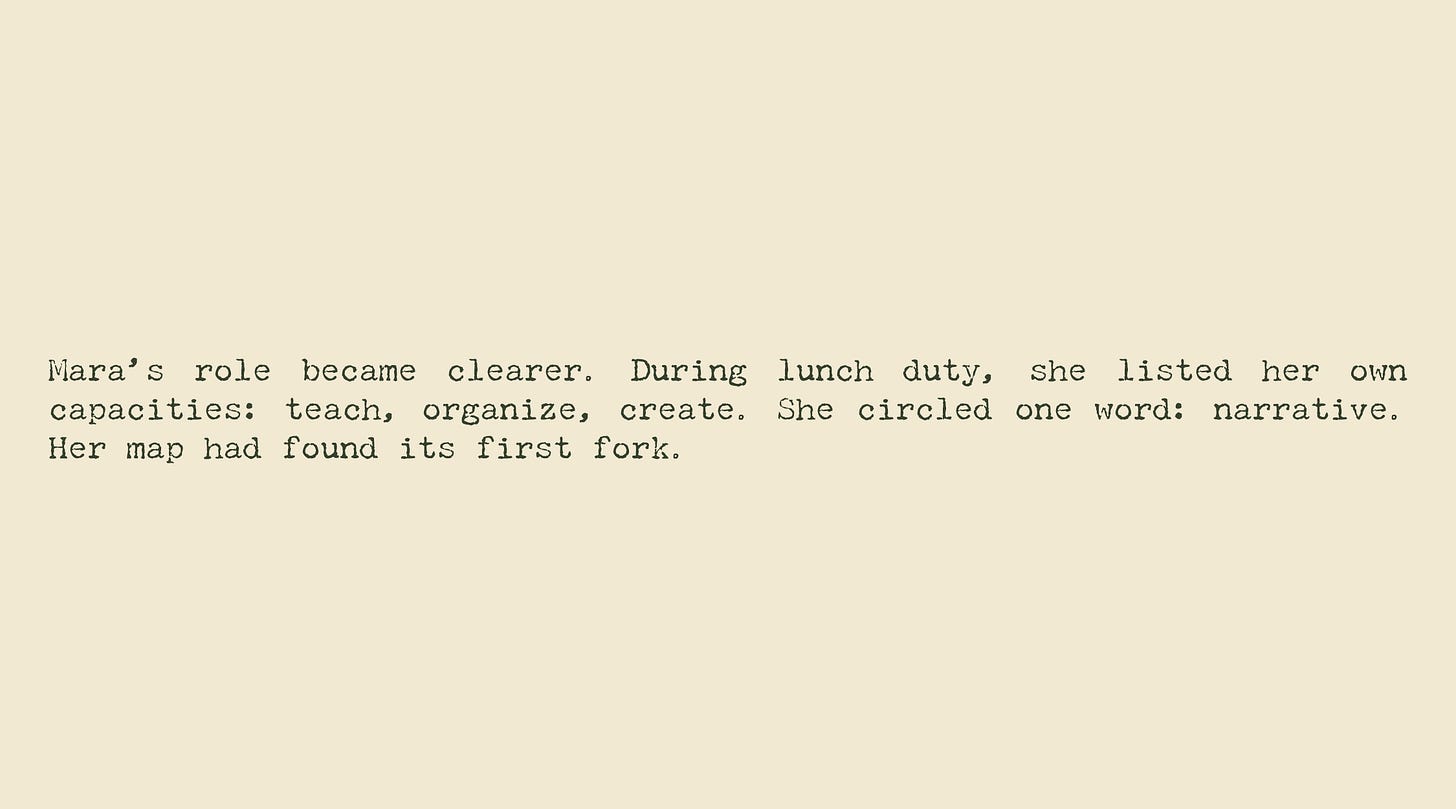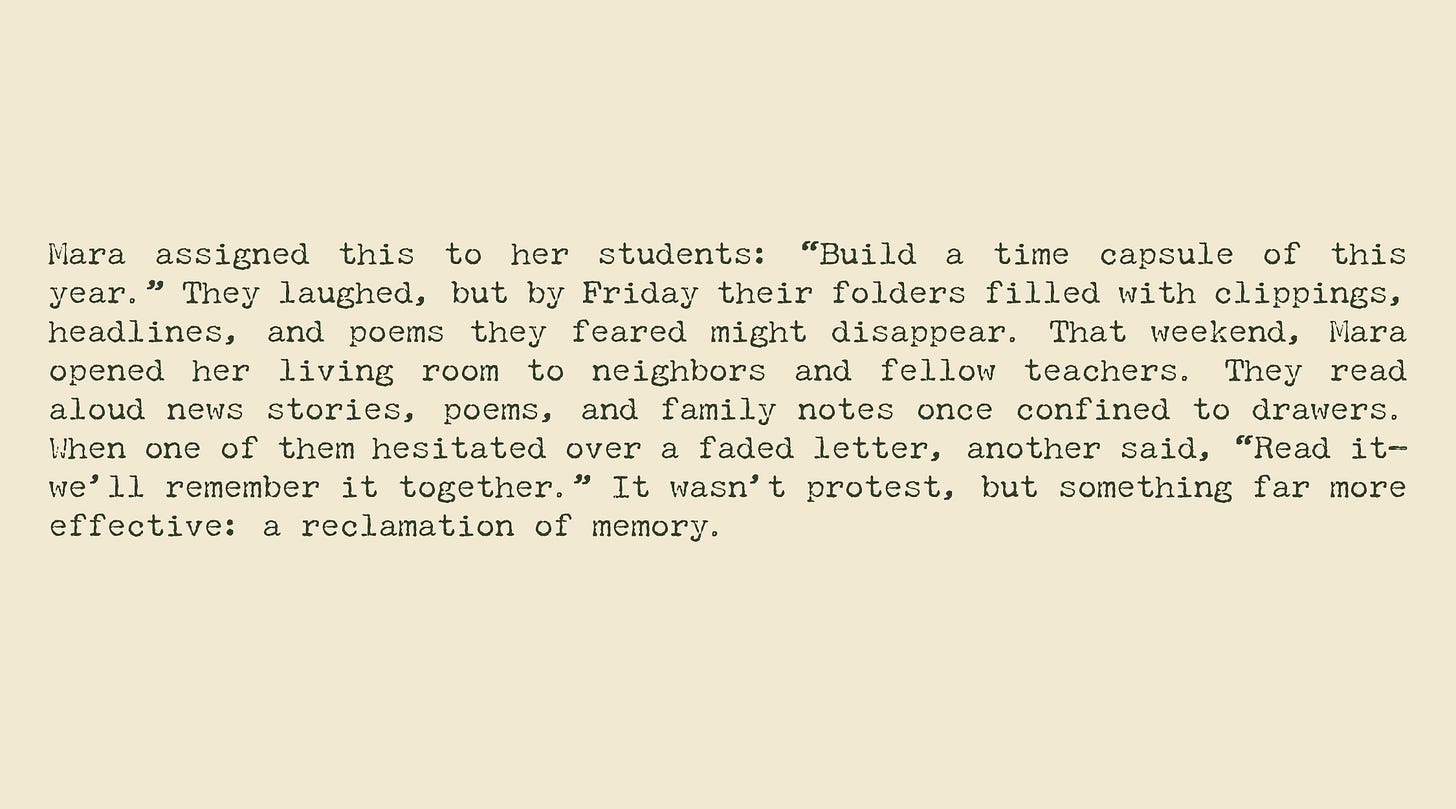Narrative Resistance — Defending Truth and Memory
Part One of The Four Domains of Cultural Resistance. When meaning itself becomes contested, every witness, teacher, and storyteller becomes a defender of truth.
🔧 Torchlight Praxis — Tools You Can Carry
Narrative resistance is what we choose to remember—and what we refuse to let vanish.
The Hand-Printed Page
Mara Ortiz pressed the print key before the app decided to refresh her feed again. The post had already vanished from three other platforms that morning, making it harder for people to discover the article from a small rural newspaper. The printer hummed, warm air rising as the page fed out—ink, paper, proof.
She slipped it into her binder labeled Recipes for Freedom—a messy collage of clippings, recipes, and reflections that had become her quiet archive of the present. Between pages for bread and soup, her handwriting curled across the margins: notes, sketches, fragments of overheard truth. She called it her DIY survival manual, but it was really a ledger of witness.
That night, while feeding her sourdough starter, she wondered why it mattered. What difference could one printed page make? Maybe resistance didn’t always begin with shouting. Maybe it began with remembering.
The Framework of Cultural Resistance
Introduced in What Are We Supposed to Do? (Community Edition), this framework grew from research on how ordinary people practice resistance through cultural means rather than purely political ones. That foundation shapes the way each domain (narrative, economic, community, and personal resilience) connects individual practice to community strength.
Cultural resistance isn’t a slogan or a movement; it’s the quiet refusal to let meaning be stolen. It’s what people carry with coded songs, hide in hand-bound books, and smuggle into places they’re banned. It doesn’t overthrow power directly. It preserves what power fears most: a people who can still tell the truth about themselves and their neighbors.
The goal of cultural resistance is coherence—stitching together the stories that keep a community from unraveling. Its four domains—narrative, economic, community, and personal resilience—are interlocking ways of tending to that fabric. Each of us enters where we can, with what we have.
The Power and Peril of Story
Control the story, and you control the possible. Release the story, and you return the world to itself. Every regime begins by rewriting the dictionary; every free person begins by writing it back.
Propaganda doesn’t persuade—it exhausts. It floods, confuses, and numbs until disbelief feels like self-defense. The firehose effect overwhelms the mind; whataboutism replaces accountability with distraction; semantic drift blurs the moral compass until cruelty feels ordinary. These tactics aren’t accidents—they’re weapons.
Yet stories can also repair what was broken. The banned poets of Chile smuggled verses into song; librarians in Sarajevo rebuilt their archives under fire; a high school newspaper that once faced censorship now teaches students to fact-check better than the adults around them. Each act of preservation or retelling widens the horizon of what people can imagine again.
The antidote isn’t louder messaging; it’s slower attention. Narrative resistance starts when we resist speed itself, when we pause long enough to name what’s being erased. It’s an act of care disguised as clarity.
The Classroom
In her classroom, Mara asked, “Who decides what counts as truth?” The room went still. Students shifted in their chairs, glancing at each other, waiting for her to supply an answer she didn’t have. That silence became her lesson: the stories we can’t tell are the ones that rule us.
Later, she tacked a new phrase to her bulletin board: Freedom is the ability to finish a sentence without permission.
Finding Your Role
Narrative resistance doesn’t belong only to journalists. It belongs to witnesses, teachers, archivists, artists—anyone who chooses clarity over convenience. It might look like a parent curating stories that tell their family’s real history, or a retiree scanning old photographs and adding forgotten context.
Mara’s role became clearer. During lunch duty, she listed her own capacities: teach, organize, create. She circled one word: narrative. Her map had found its first fork.
Your role begins where you already stand.
Start where you can stay. Maybe it’s documenting a neighborhood’s history, translating a story, or preserving family letters. Maybe it’s simply refusing to forward what you can’t verify. Maybe today, it’s taking time to wave at the cars and neighbors I pass by when I walk the dog. Each act—what you choose to amplify, what you choose to archive—is an ethical choice, and together those choices form the culture we keep.
And never forget: You’re not alone. Resistance is an ecosystem built from individuals, communities, organizations, and others who refuse to watch the truth be torn apart.
Practices
Archive the Present (Low Risk)
Print or digitally store stories, testimonies, and art likely to vanish. Label your archive with care: author, date, source.
Objective: Preserve truth and context.
Ethical Note: Protect privacy; verify sources; store safely.
This action is quiet and reflective—the solitary rhythm of keeping watch.
Mara assigned this to her students: “Build a time capsule of this year.” They laughed, but by Friday their folders filled with clippings, headlines, and poems they feared might disappear.
Memory Fire (Moderate Risk)
Host a living-archive night or oral-history exchange. Listen as if history depends on it—because it does.
· Objective: Keep quiet, suppressed or overlooked stories alive.
· Ethical Note: If you plan to publish your archive or post event photos and videos, get consent from folks first; protect people’s stories; credit your sources. This action is communal, warm, and brave.
That weekend, Mara opened her living room to neighbors and fellow teachers. They read aloud news stories, poems, and family notes once confined to drawers. When one of them hesitated over a faded letter, another said, “Read it—we’ll remember it together.” It wasn’t protest, but something far more effective: a reclamation of memory.
How do You Practice Narrative Resistance?
These examples aren’t prescriptions—they’re just examples to inspire you and help you consider your options. Choose or create a practice that fits your capacity, community, and resources.
Low-Risk / Minimal Time
Fact-Check Before Sharing — verify a post or claim before reposting, model discernment for others.
Start a Book Club — read banned or challenged books aloud and talk about why they matter.
Keep a Reflection Journal — record your thoughts about daily news or personal events; your memory is historical data.
Moderate Commitment
Volunteer with a Literacy or Educational Nonprofit — help someone else gain access to story and language.
Start a Community Newsletter or Blog — share verified local news, interviews, and small celebrations that larger outlets ignore.
Document Neighborhood History — interview elders, gather photos, or map landmarks with community members.
Higher Commitment / Collective Effort
Create a “Family Forest” Project — collaborate with neighbors to weave family trees into a public art mural or archive.
Host a Freedom Library — circulate banned or underrepresented books from your home or local space.
Attend School Board or Council Meetings — speak for truth in educational and public policy discussions.
Mentor Young Storytellers — help students or youth writers learn the craft of honest storytelling and ethical research.
Risk and Reflection
Research on media consumption shows that chronic exposure to conflicting information depletes attention and empathy and that repeated encounters with misinformation reduce users’ willingness to engage with any news at all. This kind of disinformation fatigue is one of the quietest threats to civic trust.
Not every story is yours to tell. Some truths need care before exposure. Risk isn’t proof of courage; it’s a cost that must be weighed. Protect what you love, not just what you oppose.
Digital footprints can endanger others; fatigue can silence you faster than censorship. Guard both compassion and stamina. In the long work of cultural resistance, exhaustion is one of the enemy’s oldest tools.
Mara hesitated to post her students’ projects online. She decided instead to share them privately—a small act of informed discretion—a big lesson in sharing freedom.
Daily Reflections & Pivots
Still not sure where to begin, or just looking for a way to listen more deeply?
Resistance is rhythm, not reaction. Beginning often means pausing long enough to notice and remember. The goal is not to choose something for the sake of motion or to shout over the noise. It is to make sure your signal endures.
When you don’t know where to start, start by asking questions.
Daily Reflection: As you move through the day, notice the stories you encounter—on the news, in conversation, in your own thoughts. Ask yourself, What will happen to this story? Will it fade, change, or find another keeper?
Weekly Pivot: Take time to reflect on the stories you have heard about freedom. What happened in them? Who told the story, and who was left out?
These small practices strengthen attention and memory, helping you stay grounded in what is real rather than what is loud. They also reveal how power and memory shape the narratives around you, so you can begin to tell a truer story of your own.
Bread & Meaning
Months later, the binder was heavier. Mara slipped another printed article into it—one her students had written this time. The Recipes for Freedom now bulged with pages and was dusted with flour, a patchwork of lessons, stories, and small victories.
The dough she’d been kneading rose beside it on the counter, the starter richer than when she began. The smell of yeast and ink mingled—a scent of patience and persistence. On the binder’s new divider tab she wrote one word: Truth.
Outside, the streetlights flickered in a line down the street, small torches against the dark. Maybe resistance starts here, she thought—not in the act of keeping one loaf or one page alive, but in sharing what rises from them.
Next Wednesday: Economic Resistance — Reclaiming the Means of Survival.
This is Part One of our four-part Torchlight Praxis series, The Four Domains of Cultural Resistance.
Subscribe to stay in the loop. New essays release every Wednesday.
Explore more from Torch & Tinder Press
📣 Signal Dispatch — Signals from the field
🔧 Torchlight Praxis — Tools you can carry (you’re here)
🔥 Embers — Warmth for the long winter
Stay connected: Instagram · Bluesky · Facebook
One-Time Support & community editions: Ko-fi
Support the work:
Subscribe free on Substack to receive every post.
Become a Paid Subscriber ($8/month or $80/year) to help fund print releases and join Refuge Bonne Foi.
Join as a Torchbearer ($240/year) for early access to Core Collections and digital issues.
Group discounts: 20% per seat (min. 3).
Prefer a one-time gift? Support us on Ko-fi.
Source Acknowledgements
This essay builds on our field guide What Are We Supposed to Do? Practicing Cultural Resistance (Community Edition), where you can find full citations of the historical, cultural, and factual sources that inform this work.
















